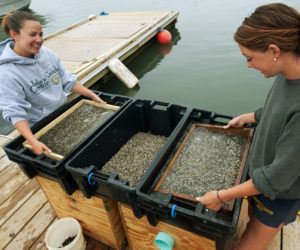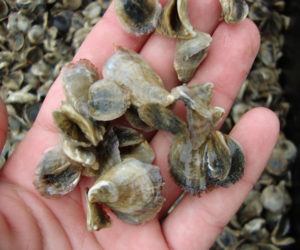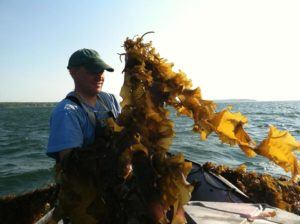Thanks To Climate Change, The World Is Not Your Oyster

Oysters are shucked unless Island Creek does something about it.
There’s nothing better than freshly shucked oysters served over ice with a side of lemon for squeezing. Unfortunately, eating oysters in months with the letter “r” may become a thing of the past thanks to overwhelming evidence that climate change is slowly but surely killing them all.
Island Creek Oysters began in 2000 in Duxbury, MA when a group of oyster enthusiasts started selling oysters to local restaurants from the back of a pickup truck. Fast forward 16 years, Island Creek is now one of the largest oyster companies in the United States, with five Boston-area restaurants, a massive distribution arm that sells over 200,000 oysters a week, and a non-profit foundation committed to creating sustainable food sources for developing countries [1].

So how did Island Creek Oysters get here? It all comes down to one word: aquaculture. According to the National Oceanic and Atmospheric Administration (NOAA), aquaculture is “the breeding, rearing, and harvesting of plants and animals in all types of water environments” [3]. Realizing that oysters are a sustainable food source, Island Creek has been farming them in their own backyard for years. Their hatchery, located in the Duxbury Bay, is where they plant oyster larvae and grow them to market size, all the while closely monitoring the chemicals and nutrients in the water to make sure the oysters are safe to consume. Having such a successful farm for over a decade has helped the founders realize that they can teach other parts of the world that are struggling with global food production about sustainable sources of protein like oysters. While this is an incredibly noble initiative, Island Creek Oysters also needs to think about ways to sustain their own business before the real threats of climate change come knocking at their door.
With ocean temperatures on the rise, the sea has become extremely acidic and that has had a detrimental impact on marine life [2], particularly on shellfish. According to the NOAA, ocean acidity has increased by a staggering 30% over the past 200 years and if we continue emitting carbon dioxide at the current rate, global oceans could be 150% more acidic in 2100 than they’ve been in the last 20 million years [6]. As acidification increases, shellfish will be unable to properly form their shells and thus, their shells will become thinner, their growth will slow down and their death rate will increase. All of this is bad news for the Island Creek Oyster Company.

Luckily, the Northeast has not been affected by acidification … yet. However, hatcheries along the West Coast have been suffering from this for years. Between 2005 and 2009, larvae production in oyster hatcheries along the West Coast dropped by as much as 80%. [4] It is in Island Creek’s best interest to take note of the oyster devastation sweeping the West Coast in order to sufficiently prepare for what is surely coming their way.

So what can Island Creek Oysters do to mitigate the potential effects of climate change on their business? Firstly, they can consider branching out to different species across different farming locations. Right now, they are farming only oysters in one owned location, meaning a majority of their business could be destroyed if acidification takes hold in the Northeast. While building more farms up and down the East Coast and harvesting new species is costly, the costs outweigh the potential risk of their entire business collapsing because of warming ocean temperatures. Some locations and some species might fare better than others, and having that optionality is crucial if they want to sustain their business in the long term. Secondly, Island Creek can introduce kelp to their farms, as it has the ability to pull carbon dioxide out of the water. Plants in the ocean comprise of just .05% of all plants on land, and yet they are so efficient at absorbing carbon that they go through approximately the same amount of carbon as all land-based plants on a daily basis [5]. If Island Creek can harness this power in their own farms, they will be more likely to defend their oysters from the harming effects of acidification at very little cost.

While many businesses are not willing to implement strategies to mitigate the potential effects of climate change, I am confident that Island Creek is not one of them. They have proven through their non-profit work that they are committed to making the world a better place for future generations. Introducing new ways to protect their business from rising ocean temperatures and increasing acidification aligns with their core belief of investing in the future. After all, that’s what aquaculture is all about.
Word Count: 780
WORKS CITED
[1] Island Creek Oyster Company Website
http://islandcreekoysters.com/
[2] Climate Change in 2016: Implications for Business (Harvard Business School Case)
[3] NOAA Fisheries Website, “What Is Aquaculture”
http://www.nmfs.noaa.gov/aquaculture/what_is_aquaculture.html
[4] Science Friday, “For Oysters, Challenges and Hope in Changing the Ocean”
http://www.sciencefriday.com/segments/for-oysters-challenges-and-hope-in-the-changing-ocean/
[5] Environment 360, “How Growing Sea Plants Can Help Slow Ocean Acidification”
http://e360.yale.edu/feature/kelp_seagrass_slow_ocean_acidification_netarts/3013/
[6] Grist, “Climate Change Pantry Raid: Oysters”
http://grist.org/article/2011-11-21-climate-change-pantry-raid-oysters/



This is really interesting, and to a big oyster fan like myself, pretty troubling. Have any oyster companies tried to create wholly artificial farms? It sounds like Island Creeks’ Duxbury hatchery is still susceptible to increasing acidity and other changes in condition. Could they move the hatchery onshore, into an artificial lake of sorts? I imagine that this would be very costly and operationally complex given how many oysters they hatch. Maybe there’s an opportunity for a group of oyster companies to come together to jointly invest in an artificial farm, sharing the upfront investment. Seems like it’s a hedge that would be worth exploring as acidity rises. Also, great title, great lede.
Definitely craving some oysters after this article! In recent years, there has been a big push to inform consumers of which types of fish are more sustainable than others. I know this initiative has had a major impact on my purchasing decisions and I believe many others. Given that you mention there may be other types of species of oysters that are more resistant to increased acidity, do you think an initiative to inform consumers about the benefits of these species in the hopes of shifting consumer demand? Or are oysters commoditized enough that it is not necessarily demand which is informing the farming decisions of Island Creek and instead they are simply reacting to ocean conditions?
Great post amiga. While I am not much of an oyster fan myself, I am intrigued that such seemingly small changes in climate have already affected some hatcheries’ output by 80%. How much more resilient is having a farm in the backyard like Island Creek to these climate changes? Can it be a completely separate, man-made body of water that can be protected entirely from climate change? I suppose I’m curious as to what levers affect the viability of aquaculture technology in different settings, and if we would ever have to resort to it at a large scale from continued climate change.
So first and foremost, the puns in this article are unreal! Secondly, the content is fascinating. I wasn’t aware that “underwater plants” such as kelp processed CO2 at an equivalent efficiency of land based plants. I’d be interested in understanding how far-reaching the neutralizing effect of kelp can be (i.e. could oyster farmers effectively maintain suitable water pH in a body of water purely by additional kelp?). Additionally, are there any farming techniques to encourage kelp growth? Given that the taste of an oyster is unique to the location it was grown, forced relocation of oyster farms is likely to have a significant impact on the flvavor that people have come to know and love.
This is a really interesting article and great to hear about how oyster companies can contribute to increasing the sustainable food sources in the world at a time when food scarcity is a growing concern. One aspect of the oyster industry that concerns me with regard to climate change is the transportation costs as oysters need to be transported alive from the oyster farms to the end user (restaurants and supermarkets) where customers can purchase them. Island Creek Oyster is a local company in the Boston market, but restaurants here do often offer oysters from locations farther away such as Maine, Virginia and the West Coast. I’d be interested to learn more about the climate impacts of transporting oysters from the West Coast to the East Coast and for Island Creek to sell their oysters on the West Coast. This would also need to be taken into consideration when deciding if Island Creek should expand their growing locations outside of Duxbury – will they now be causing increased pollution in an attempt to react to the acidification of the water as a result of climate change?
Hey Kelly,
Very interesting post. I love the word, Aquaculture! It perfectly embodies what Island Creek Oyster is trying to do. First off, it is admirable that it has committed to creating sustainable food sources for developing countries – at least the ones that are not landlocked. You mentioned that it might not be possible to eat oysters in fall/winter months (months with the letter r), but I’m unclear as to how acidification only affects the ocean during the winter. If rising ocean temperatures cause the water to become acidic, I would expect peak acidity and trough levels of oysters in the spring/summer. Thoughts?